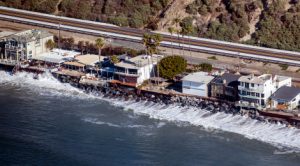Thanks to the OCR for this article – link at bottom:
Sounding the latest alarm over the devastating impacts sea level rise is expected to have on the California coast, a new report from the state Legislative Analyst’s Office details the critical need for action over the next decade and notes that most preparations so far are only in beginning stages.
Between $8 billion and $10 billion of existing property will be underwater by 2050 and another $6 billion to $10 billion will be at risk at high tide, according to a study cited in the report.
“The certainty of rising seas poses a serious and costly threat,” according to the Legislative Analyst’s Office, a nonpartisan governmental agency that provides policy advice to the state Legislature.
For every dollar spent preparing in advance of disasters, $6 in post-disaster losses are avoided, according to a federal study cited by the Legislative Analyst’s Office. With the state estimating a half-foot or more of sea level rise by 2030 — and as much as 7 feet by 2100 — the report says it’s crucial to take extensive measures over the next 10 years or so.
“After that point, sea levels may already have risen by around 1 foot in many locations,” the state report says. “Once sea levels have risen to higher levels, the planning window narrows and options for how local governments can respond become more limited.”
As an example, the report points to how coastal marshes can be established and fortified to create natural buffers against waves. But if those new marshes aren’t established by 2030, they “may not have sufficient time to develop.”
Prognostications of sea level rise — especially decades into the future — vary widely. Estimates for 2100 range from 1.5 feet to 7.1 feet, according to the state report. But there’s widespread agreement among climate scientists that the sea will rise dramatically as the planet warms and polar caps melt, and some recent forecasts put estimates higher than previously predicted.
The new report relies heavily on studies performed by others, but compiles them to provide a comprehensive look at the impacts, challenges and preparatory strategies involved.
With sea level rise of 3 feet to 6 feet, “up to two-thirds of Southern California beaches may become completely eroded by the year 2100,” says the state report, citing research by the United States Geological Survey.
The same research says that by 2100, 6 feet of sea level rise combined with storms “could impact over 480,000 California residents and $119 billion in property value in 2010 dollars,” the report says.
The erosion of beaches, dunes and coastal cliffs will jeopardize shorefront homes, businesses, roads and other infrastructure.
“California would probably have to build as many as 100,000 additional [housing] units annually — almost exclusively in its coastal communities — to mitigate housing affordability problems,” the report says. That’s in addition to the 100,000 to 140,000 units typically built in the state annually.
Sea level rise could also hurt the coastal economy created by tourism, recreation and marine transportation, which is valued at more than $44 billion a year, the report says.
Link to full article




30 years ago I was promised the Maldives would be underwater by now.
LOL Jim.
C’mon your virtue signaling is showing.
Recently the City Council of Encinitas had two secret meetings about a homeless parking lot on Saxony Road.
That same City Council had a public meeting on the fable also known as sea level rise and brought in some pretty creepy folks with zero credibility to push their ridiculous agenda.
I know a lot of folks with big $$ are pushing this agenda.
While I won’t claim here and now that they have single digit IQ’s due to the fact that the genius Taleb has pretty much proven IQ is somewhat of a farce I will confidently mention that educated derelicts abound these days and we’re due for a major washout to get folks refocused.
Have a knice day
C’mon Jim lets do away with the virtue signaling.
Recently the Encinitas City Council had two secret meeting about a homeless parking lot on Saxony Drive.
That same City Council had a public meeting on sea level rise and brought in some pretty shady characters none of which had any real and non-propaganda type data to prove their non-point as to why we all should take them seriously.
Let’s hear your view if sea level rise is in fact a real issue with the lives we live now and in the future.
I’ll give you hint…it’s not and your virtue signaling may glean you business but it’s totally lame.
https://youtu.be/e82smfcypUc
It seemed like a natural story of interest following the Coaster video.
I don’t have an opinion about sea level or climate change or Mr Magoo. You have an opinion, apparently, so you assume that I have one that’s different, and you take aim at me? You’re in the wrong place – gather up your youtubes and go back to the climate change blogs.
P.S. The homeless parking lot is across the street from the Compass office. You’re not going to accuse me of trying to take advantage of that, are you?
Good Explainer: https://www.youtube.com/watch?v=xOEOPI-YeXs
Many thousands of years.